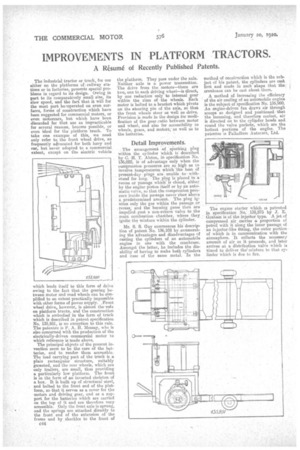IMPROVEMENTS IN PLATFORM TRACTORS.
Page 28

If you've noticed an error in this article please click here to report it so we can fix it.
A Ksume of Recently Published Patents.
The industrial tractor or truck, for use either on the platforms of railway stations or in factories, presents special problems in regard to its design. Owing in part to its comparatively small size, its slow speed, and the fact that it will for the most part be/operated on even surfaces, forms of construction which have been suggested for commercial motors, or even motorcars, but which have been discarded for that use as impracticable for several reasons, become possible, or even ideal for the .platform truck. To take one exampte of this, we need. only refer to the front wheel drive, so frequently advocated for both lorry and car, but never adopted to a commercial extent, except on fire electric vehicle which lends itself to this form of drive owing to the fact that the gearing between motor and road wheels can be simplified to an extent practically impossible with other forms of power supply. .Front wheel drive,. however, is almost the 'rule on platform trucks, and the construction which is embodied in the form of truck which is described in patent specification No. 135,951, is no exception to this rule. The patentee is P. A. H. Massay, who is also concerned with the production of the electrically-driven commercial motor to which reference is.made above.
The principal objects of the present invention seem to be tins care of the batteries, and to render them accessible. The load carrying part of the truck is a plain rectangular structure, suitably gusseted, and the rear wheels, which are only trailers, are small, thus providing a particularly low platform. The front is in the form of an inverted skeleton of a box. It is built up of structural steel, and bolted to the front end of the platform, so that it serves as a cover for the motors and driving gear, and as a support for the batteries which are carried on the top of it and are therefore very accessible. Only the front axle is sprung, and the springs are attached directly to the front end of the extension of the frame and by shackles to the front of
c44
the platform. They pass under the axle. Neither axle is a power transmitter. The drive from the motors—there are two, one to each driving wheel—is direct, by one reduction only to internal gear within the rims of the wheels. Each motor is bolted to a bracket which pivots on the steering pin of the axle, so that the front wheels steer as well as drive. Provision is made in the design for modification of the gear Isatio between motor and wheel, and also for accessibility to wheels, gears, and motOrS, as well as to the batteries.
Detail Improvements.
The arrangement -of sparking plug within the cylinder which is described by O. H. T. Alston, in specification No. 136,022, is of advantage only when the compression pressures are so high as to involve temperatures_ tvhich the best of present-day plugs are unable to withstand for long. The plug is placed in arecess or passage which" is closed, either by the engine piston. itself or by an automatic valve, so that the compression pressure inside the passage never rises above a predetermined amount. The, plug ignites only the gas within the passage or recess; and the burning gases thCn are, impelled past a non-return valve to the main combustion, chamber, where they ignite the mixture within the cylinder.
Mr. S. S. Guy commences his description of patent No. 136,108 by enumerating the advantages and disadvantages of casting the cylinders of an automobile engine in one with the crankcase. Amongst the latter, he includes the disability of having to make both cylinders and case of the same metal. In the method of construction which is the subject of his patent, the cylinders are cast first and made in such shape that the crankcase can he cast about them.
. A method of increasing the efficiency of the air cooling of an automobile engine is the subject of specification No. 135,980. An engine-driven fan draws air through scoops so designed and positioned that the incoming, and therefore coolest, air is directed on to the cylinder heads and round the valve pockets, which are the hottest portions of the engine. The patentee is Palladium A.utoca.rs, Ltd.
The engine starter which is patented in specification No: 135,875 by J. E. Graham is of the injector type. A jet of compressed air carries a proportion of petrol with it along the inner passage of an injector-like fitting, the outer portion, of which is in communication with the atmosphere. It collects the necessary amount of air as it proceeds, and later arrives at a distribution valve which is timed to deliver the/ mixture to that cylinder which is due to fire.




























